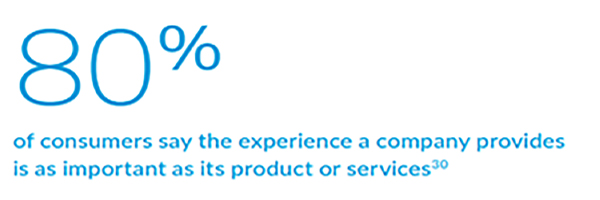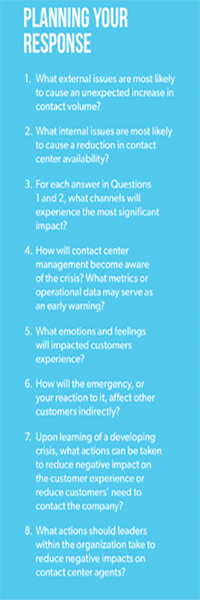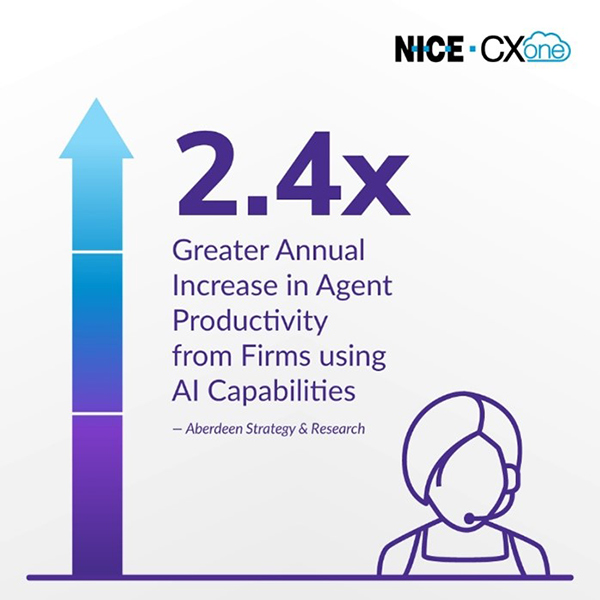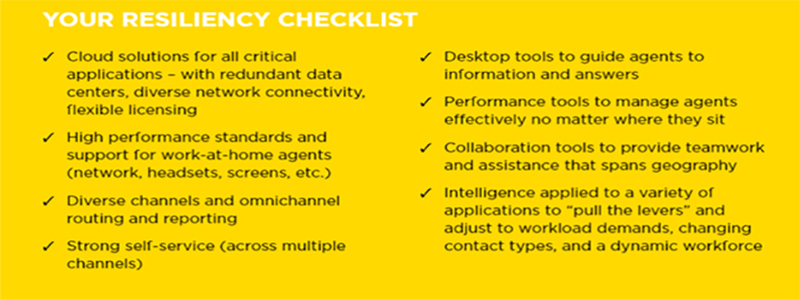The holiday shopping season can make or break a retailer's entire year. Contact centers are used to the holiday spike in transaction volume, but this year may be even more challenging for retail businesses and contact center agents to navigate. Supply chain issues will likely generate more contacts and interactions from customers who are disappointed about low inventory and delayed shipments.
This begs the question… is it really the most wonderful time of the year?
That expectation only increases around the holiday season, when the amount of transactions skyrocket.
I began my Christmas shopping a few weeks ago, even though it was before Halloween. Normally, I do most of my gift buying on Black Friday and Cyber Monday, but this year is different. Distribution channel disruptions and delays are moving up the holiday shopping timeline for many of us, and procrastinating shoppers may find themselves on a call or chat line trying to track down items.
By now, we've all seen the pictures of container ships backed up at major U.S. ports. The backlog has resulted in empty shelves at grocery stores and major retailers, and compounding the issue is a truck driver shortage. Overall, the supply chain is like frozen pipes—things are moving slowly and inconsistently, and the worry is that the pipes might burst.
Like most, I have experienced these supply chain issues firsthand. My typically reliable monthly subscription service has not been able to deliver items ranging from cat food to candy, and I recently received an email from the president of one of my favorite clothing retailers explaining that shipments would be delayed because a good portion of their inventory is stuck on cargo ships. Talk about a crazy time for retailers.
The furniture industry has been hit particularly hard. Last year it was toilet paper and this year, it's king-sized beds and dining tables. Furniture companies are facing issues from increased consumer demand to materials shortages to decreased factory output, all of which have increased delivery times. In some cases, this ranges from six weeks to nine months.
And don't even get me started on car shopping; that’s possibly the bleakest market of all for buyers right now. My wife and I went to buy a new car just last month and when we asked if they had a specific color of the car we were looking at, we were met with laughter from the salesmen. There’s such a shortage of cars right now most consumers are expected to take what they can get, no questions asked.
What the supply chain issues mean for contact centers and customer experience
Most of your customers have seen news of late deliveries and are at least prepared psychologically and (hopefully) shopping earlier. The latter behavior means you might see contact center volume begin to ramp up earlier than usual.
But even though people know what to expect doesn't mean they won't run into issues and be disappointed, especially if they learn it will be another nine months until they can sleep in their new bed. And forget about that brand new dining set making it in time for Thanksgiving dinner.
The busy holiday season is like Superbowl season for many companies. It’s a time of year that proves stressful for contact center staff, especially the agents who handle back-to-back interactions all day. This year could yield the added stress of customers who are frustrated about empty digital shelves and late deliveries.
This is also a unique opportunity for contact centers to step up to the plate and save relationships by delivering empathetic customer experiences. If a contact center’s technology is disparate or complicated, it will take away from an agent’s ability to empathize with the customer’s experience, lowering both customer and agent satisfaction. Contact center leaders can ensure their agents have strong soft skills and receive regular coaching to keep those skills sharp.
The power of an empathetic customer experience
Contact center leaders are aware of the pivotal role customer service plays in building relationships with customers. They can optimize customer service by delivering experiences that are personalized, effective, and memorable. A "memorable" experience is often one in which the customer feels better after the interaction than they did before. This is achieved when agents have good soft skills.
What are soft skills? Think empathy, problem solving, taking control, and active listening. These skills ultimately impact how a customer feels they are treated. For example, good active listening makes people feel like they're being heard and understood, and empathy conveys to customers that the business acknowledges and cares about their feelings.
This is an important component of CX, as 70% of the buying experience i is based on how the customer feels they are treated. Forging connections with customers by treating them well is a powerful way to improve business results. One study found that 83% of consumers ii say they are more willing to do business with a brand if they feel a personal connection, and 57% report increasing their spending iii with companies they connect with.
But the effective use of soft skills isn't just limited to sales. Soft skills are also essential for building customer loyalty and reducing churn, which is why they’re particularly important this holiday season. A best practice for contact center agents is to listen to customers and display empathy when customers are frustrated that the item they wanted to purchase is out of stock or won't arrive until February.
Leveraging AI to monitor and improve contact center agent soft skills
Contact center supervisors know that soft skills are important, but a firm grasp on how well agents use soft skills has historically been elusive for them. Soft skills are typically inspected during the quality analysis process, which means only a small percentage of interactions are evaluated and coaching is done after the fact; sometimes even days later.
While listening to calls and coaching on outcomes is still an important activity, the emergence of artificial intelligence has revamped and enhanced the QA process for many companies. Software that leverages AI can listen to and analyze all voice interactions and coach agents in real-time about their soft skills. Additionally, AI-powered tools can pinpoint interactions that need further review and evaluate interactions to identify customer sentiment, contact drivers, emerging problems, trending topics, and more.
These capabilities give supervisors and managers the insights into soft skills they've always wanted, and they can use this information to ensure agents are delivering the empathetic, loyalty-building service experiences customers expect and value.
Let’s take a closer look at a few AI-infused tools that help maintain strong customer relationships during the holiday season.
NICE Enlighten: AI for Empowered Agents and An Elevated Customer Experience
NICE Enlighten is our artificial intelligence platform that powers several of our applications. It's the only AI engine in the industry that was built specifically for customer engagement. Because the platform was developed by processing billions of service interactions, it has a unique understanding of human nature and knows the behaviors that create satisfied customers. And because it is custom-built for contact centers, NICE Enlighten can be used out of the box because the software requires little to no training.
Real-time Interaction Guidance Give Contact Center Agents a Clear Path to Navigate
Real-time Interaction Guidance is an application that leverages the NICE Enlighten AI engine to improve CX. Real-time Interaction Guidance software listens to every voice conversation and identifies customer emotions. It then coaches agents in real-time about soft skills that have been proven to increase customer satisfaction. For example, the software alerts agents if they're talking too fast, interrupting callers, or if they need to show more empathy for the customer’s situation.
This tool solves the issues of only evaluating the quality of a small sample of interactions and coaching agents after the fact, when it might be too late to secure customer satisfaction. It easily scales to evaluate every call handled by every agent across the contact center. And because it coaches agents during interactions, agents have the opportunity to act on that guidance to improve the tone and outcome of each conversation.
Real-time Interaction Guidance software also assists supervisors with agent development. 27% of employees strongly agree that feedback improves their job performance, yet supervisors only spend 7% of their time coaching iv agents. Real-time Interaction Guidance software doesn't replace supervisor input, but it's a valuable way to provide agents with a deeper level of performance insights.
To learn how your business can optimize Real-time Interaction Guidance, download the Aberdeen study .
Interaction Analytics Help Determine Customer Satisfaction
Interaction Analytics also uses AI to provide valuable insights about many of the drivers of customer satisfaction. The tool analyzes all interactions from all channels to give contact center leaders a holistic view of the customer experience.
Below are some examples of the information provided by Interaction Analytics.
- Customer sentiment. The software uses factors such as keywords, voice pitch and volume, and the length of silences to determine if a customer feels positive, negative, or neutral during the interaction. Sentiment scores are drilled down to the agent level so supervisors can identify potential development opportunities. Measuring and trying to improve customer sentiment will be particularly important this holiday season when the likelihood of anxious callers is projected to rise.
- Emerging problems and contact drivers. Interaction Analytics identifies common keywords and phrases to identify why customers are calling. This enables managers to identify new issues and proactively fix them. Good problem management is essential when time is of the essence during the all-too-short holiday season.
- Measure and analyze critical behaviors. This new feature provides insights into nine critical agent behaviors across 100% of voice interactions. This almost real-time analysis provides the information contact center leaders need to identify training gaps and pinpoint agents who need coaching to strengthen their soft skills.
To see this valuable tool in action, check out a case study where one of our clients experienced a 22% increase in their customer sentiment scores thanks to interaction analytics.
Quality Management Analytics Drives Contact Center Excellence
Did you know supervisors spend 35% of their time v looking for coaching opportunities? That's five times the amount of time they dedicate to actually coaching agents. Quality Management Analytics software also leverages the AI engine to make it easy for supervisors to find interactions to evaluate so they can spend more time developing agents and less time searching for a needle in a haystack that could be an optimal instance for coaching.
The new version of CXone Enlighten AI evaluates agents on nine key soft skill behaviors that influence customer satisfaction. This allows supervisors to quickly and easily identify very targeted training topics that will improve customer service experiences. A streamlined QA process frees up supervisor time and empowers them to put more focus on ensuring that customers—especially frustrated holiday shoppers—receive competent, empathetic service.
Need an example? Here’s a demo of how this tool works:
Performance Management Levels Up Agent Experience
Results of QA evaluations and sentiment scores are more effective at improving behavior and performance if they are highly visible to everyone in the call center. Advanced Performance Management software includes role-specific dashboards that create an environment of continuous improvement. When agents have on-demand access to their individual performance results, they're more likely to take ownership of them.
Improving soft and technical skills doesn't need to be painful. Gamification makes improvement fun by rewarding agents for meeting specific performance targets. And when team results are rewarded, it can foster an atmosphere of collaboration.
Own the customer experience this holiday season!
Every holiday season presents its own challenges, particularly for retailers of all types. But this year, there may be even more at stake. More customers may be disappointed by empty shelves and late deliveries, which means contact centers have the added pressure of saving more relationships. But with the right soft skills and technical contact center tools, your agents will be up for the task of delivering great CX in spite of supply chain issues.
To wrap it all up nicely (pun intended), here’s a checklist that will help you through this hectic holiday season:
Businesses who can successfully achieve these things will coax out and secure more lasting relationships from consumers who have gotten used to instant gratification and saturated retail markets, and any business will tell you that a pool of loyal customers is worth more in many ways than an ocean of one-time shoppers. ‘Tis the season to fill that pool to the brim.
We can help you with that and more. Access the Customer Demand Swings eBook to find out how you can hit the ground running this holiday season.
i Customer Think: Why do Customer Experience and Conversational AI go hand in hand? (2021)
ii CMS Wire: What Does Exceptional Customer Service Look Like in a Post-COVID World? (2020)
iii CMS Wire: How Contact Center Agents Benefit From In-the-Moment Guidance (2021)
iv Business 2 Community: 3 Tactics to Level Up Your Call Center Coaching with Speech Analytics (2021)
v Business 2 Community: 3 Tactics to Level Up Your Call Center Coaching with Speech Analytics (2021)









